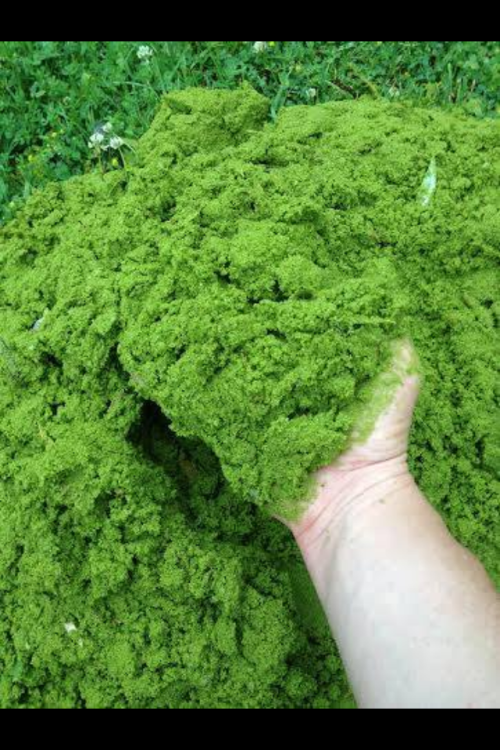Watermeal – A Fascinating Problem
August 2020 update: An updated version of this article can be found on my niche pond site, check it out. WeedyPond.com.
This post is about a problem that we faced starting in 2013. This problem damaged the view in our back yard and it even killed some fish in our pond. The name of this problem is Wolffia (otherwise known as Watermeal, a form of duckweed). No this is not a disease or a wild canine, it is a plant. And after studying this plant I am fascinated, this plant grows out of control on my property and at an alarm rate.
I calculate that if conditions are right on my pond (and they usually are), it can reproduce over 100 pounds of itself in one day.
In 2013 this watermeal plant invaded and quickly covered the pond surface by the end of June. It dies off in the fall but every year by the start of June the pond is typically covered. In some years near the end of July dozens of my large fish die from oxygen depletion in the water in the early morning hours.
This watermeal flourishing on the surface of the water chokes out sunlight at the bottom of the pond. This lack of sunlight underneath kills underwater plants which provide oxygen to the water.
This plant is a category of duckweed called Wolffia. Below are interesting facts about duckweed breeds:
- There are five breeds of duckweed.
- Wolfia is the smallest plant on earth, the entire plant is only 1 to 1.5mm.
Interesting Facts
- This plant can double in population in 4 days given the right water and wind conditions. Meaning hundreds of pounds of vegetation growth per day on my <1 acre pond.
- Watermeal and most duckweeds thrives in stagnant warm water with high nutrients.
- This plant has high starch levels which gives it potential for making ethanol.
- Some Asian countries and increasing number of feed produces farm these plants to feed to chickens, sheep, goats, or cattle. Its a high protein feed supplement that is increasingly seen as useful for animal life.
- Some people around the world actually eat duckweed plants.
- Rutgers University in New Jersey has a duckweed stock cooperative (RDSC) and does research on these interesting plants.
- The RDSC collaborates closely with a second duckweed research project at Rutgers, an international effort led by the Waksman Institute of Microbiology. Under the auspices of the US Department of Energy’s Joint Genome Initiative, to sequence the genome (~150 Mb) of the Greater Duckweed (Spirodela polyrhiza).
- The RDSC was established in 2009 with the acquisition of strains from the Biolex Corporation in NC. In addition to those collected by Todd Michael (then an assistant professor at Rutgers) and later from Professor Klaus Appenroth at the Friedrich-Schiller-Universität in Germany. As of October 2013, the RDSC has over 900 different strains, collected from all continents except Antarctica, and it continues to add to its collection.
Potential and Current Applications of Duckweeds
- Prolific growth on municipal sewage and agricultural runoff (low-cost remediation of wastewater).
- Floats on water surface (easily harvested as opposed to algae).
- High protein content in some strains (a low-cost source of animal feed).
- High starch content in some strains (a low-cost feedstock for biofuels and bioplastics).
- Low lignin content (easy-to-process soft tissue).
One reason why it’s such an efficient plant is that it doesn’t expend energy to grow a stem structure–it just floats on the water soaking up sunshine.
- Three small rootlets gather nutrients from the water, and three small leaves convert that into more duckweed. The roots don’t even have to gather water since the leaves lay flat on the water and absorb water directly.
I’m also guessing that this enables duckweed to take up carbon dioxide at an accelerated rate. Since the solubility of carbon dioxide in water is seventy times greater than its solubility in air.
Our pond water is particularly high in nutrients. This is due to four large willow trees which dump leaves and sticks into the pond almost year round.
There are many varieties of duckweed, some with leaves half an inch across, but the variety growing on my ponds is the smallest there is.
Research indicates that the smaller varieties of duckweed are more palatable to fish and humans.
This problem has also been a learning opportunity. This is a fascinating plant and I hope to take advantage of it.
As a follow up to this article click here for my Pond Restoration efforts. On my niche site weedyponds.com.
This article is not on a typical topic for me but it caught my interest so I thought I would share. Click here to learn more about me and to see what I typically write about on this site.






